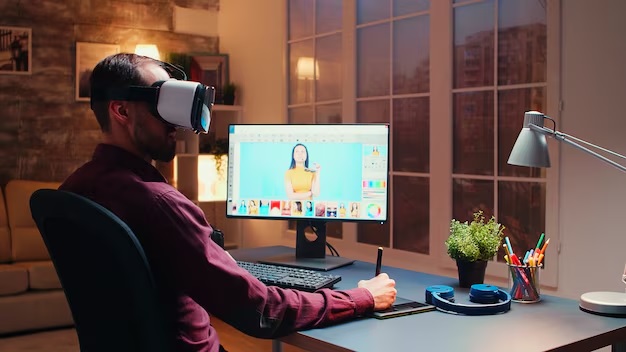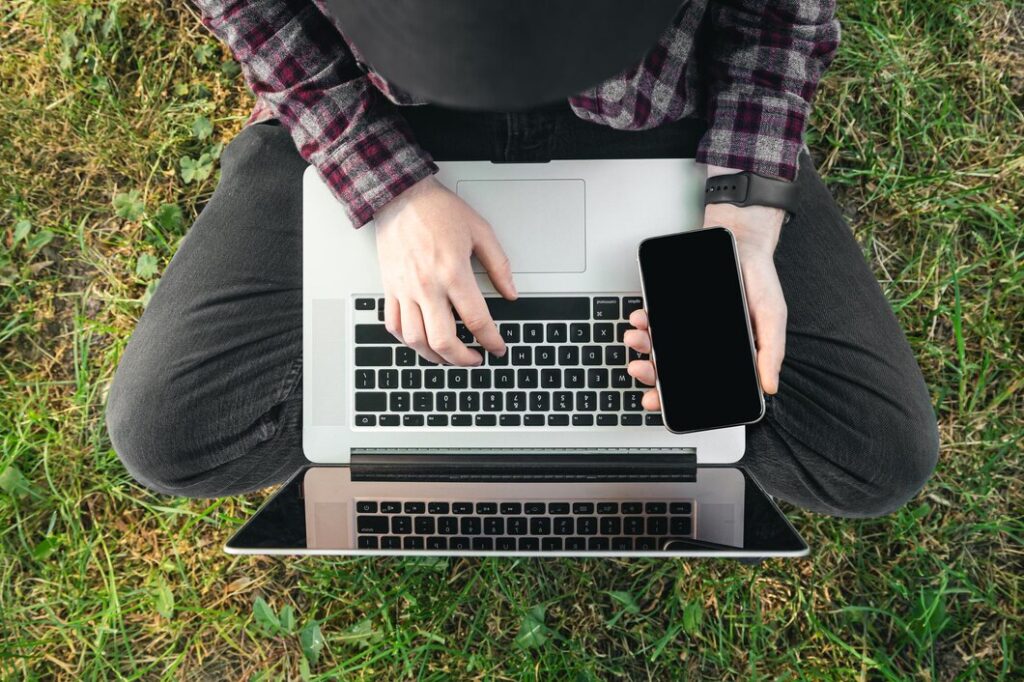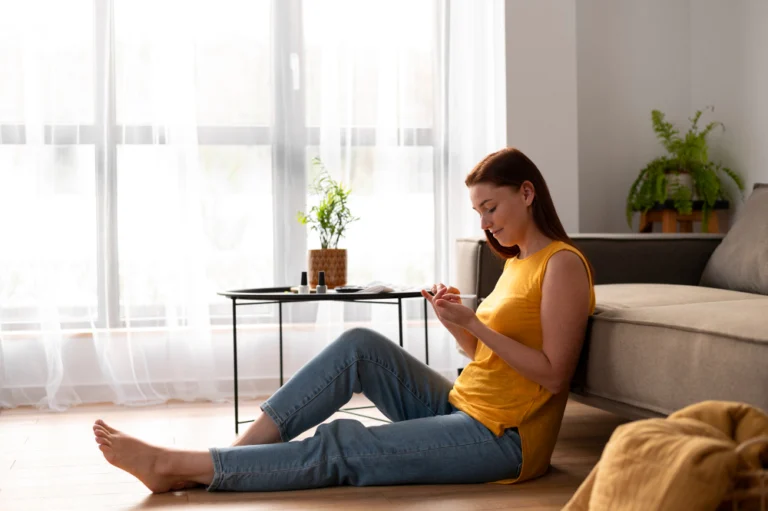
Is your digital life feeling… cluttered? You open your phone to check one email and, forty-five minutes later, you look up from a sea of notifications, endless feeds, and algorithm-driven rabbit holes, wondering where your time went. You’re not alone. This feeling of being digitally overwhelmed is the defining tension of our age. But what if you could change the rules of the game?This guide explores the vital role of digital minimalism in 2025.
You will learn how this philosophy has evolved beyond a simple “digital detox” into a crucial strategy for thriving in a world saturated with AI-driven content and ever-present connectivity. We’ll provide you with the deep insights and practical frameworks needed to declutter your digital world, reclaim your focus, and build a more intentional relationship with technology.

Beyond the Buzzword: What Digital Minimalism Really Means in 2025
Let’s clear the air: digital minimalism in 2025 isn’t about Luddism or getting rid of your smartphone. It’s not a fleeting, week-long “detox” that you abandon as soon as the work week starts. Think of it less as deprivation and more as curation.
Imagine a museum curator. They don’t just accept every artifact that comes their way. They meticulously select pieces that serve the museum’s purpose, enhance its collection, and provide value to visitors. Anything that doesn’t meet this high standard is left out. Digital minimalism asks you to become the curator of your own digital life.
It’s the conscious process of asking a simple but powerful question about every app, every notification, and every subscription: “Does this technology significantly support something I deeply value?” If the answer isn’t a clear “yes,” it’s likely just noise.
This philosophy, first popularized by author Cal Newport, has become more critical than ever. Early trends focused on temporary breaks, but we now understand that’s like putting a bandage on a broken leg.
The goal isn’t to escape technology but to reshape our use of it so that it serves our goals, not the goals of the tech companies designing it to be addictive. In 2025, it’s a sustainable lifestyle choice for anyone feeling the strain of information overload—a quiet rebellion against the attention economy.
The New Digital Noise: AI, the Metaverse, and the Evolving Attention Economy
The digital landscape of 2025 is fundamentally different from that of even a few years ago. The challenges to our attention are more sophisticated, more personalized, and more pervasive. Generative AI is now capable of creating an infinite stream of content, from articles and images to hyper-realistic videos, all tailored to keep you engaged. The “For You Page” is no longer just on TikTok; it’s becoming the default for the entire internet.
This creates a paradox. How can we practice digital minimalism when our jobs, social lives, and even creative pursuits are increasingly entangled with these powerful new tools? Many worry that opting out means being left behind.
Here’s the contrarian viewpoint: You can use these tools without letting them use you. The key is shifting from passive consumption to selective engagement. Instead of letting an algorithm dictate your information diet, you actively choose your tools for specific tasks. For instance, you might use an AI to summarize a long report for work but refuse to let its recommendation engine pull you into a two-hour Browse session.
Pattern Interrupt: A “Tweetable” Quote
“In 2025, your attention is your most valuable asset. Digital minimalism isn’t about disconnecting; it’s about strategically investing that asset.”
Furthermore, AI itself can be a tool for minimalism. Imagine AI assistants that intelligently filter your emails, block distracting notifications during “deep work” sessions, or summarize your news feeds into a single, concise briefing. The future isn’t about a war against technology; it’s about leveraging technology to protect us from… well, other technology. We’ll explore the specific tools to do this later on.
The Crucial Role of Digital Minimalism in 2025 for Mental and Cognitive Health
Why does this matter so much? Because the cost of our digital clutter is alarmingly high, and it’s measured in our mental and cognitive well-being. The constant barrage of information, the pressure to be always “on,” and the comparison culture of social media are directly linked to rising rates of anxiety and depression. Recent statistics consistently show a correlation between high screen time and poorer mental health outcomes, particularly among young adults and students.
Think of your brain’s ability to focus as a muscle. Every time you’re pulled away from a task by a notification—a “ding,” a buzz, a pop-up—you’re forcing that muscle to perform a “context switch.” This rapid shifting of focus is cognitively expensive. It depletes your mental energy, hinders your ability to engage in deep, creative thought, and ultimately degrades your ability to concentrate over long periods.
Consider this short story: Maya, a university student, sits down to study for her final exams. Her textbook is open, her notes are ready. But her laptop is also open. A Slack notification from a group project pops up. She answers it. Then she sees a new email from her professor. While in her inbox, she notices a promotional email for a flash sale. She clicks. An hour later, she’s browsed three clothing websites, scrolled through her social feed, and has made zero progress on her studying. She feels anxious, guilty, and even more stressed than before.
Maya’s story is a daily reality for millions. Digital minimalism in 2025 is the antidote. It is the training regimen for your focus muscle, allowing you to reclaim the quiet, uninterrupted mental space required for deep work, meaningful learning, and genuine relaxation.
The Minimalist’s Toolkit: A Practical Framework for a Focused 2025
Theory is one thing; action is another. Adopting digital minimalism requires a practical, structured approach. It starts with an honest audit and is maintained through consistent habits. You don’t have to do everything at once. Start with one.
Here is a step-by-step framework to begin your journey:
- Conduct a “Digital Value” Audit: For one week, list every major app and digital service you use. Next to each one, write down the specific value it adds to your life. Be brutally honest. Is scrolling Instagram truly “connecting you with friends,” or is it a tool for procrastination? This audit will reveal what is essential and what is just digital weight.
- Schedule Your Technology Use (Time-Blocking): Instead of letting technology interrupt you, give it a specific time block in your day. For example, check email from 9:00-9:30 AM and 4:00-4:30 PM. Check social media during your lunch break. Outside of these blocks, the apps remain closed. This puts you in control of the timeline.
- Curate Your Information Diet: Algorithmic feeds are designed to be addictive. Opt-out wherever possible.
- Use RSS Readers: Subscribe to your favorite blogs and news sites via a service like Feedly. You get all the content you want with none of the clickbait or algorithmic distractions.
- Switch to Newsletters: Let interesting thinkers and journalists deliver their best work directly to your inbox, which you check on your schedule.
- Turn YouTube into a Library: Turn off autoplay. Use the “Watch Later” feature to build a conscious playlist instead of falling down the recommendation rabbit hole.
- Embrace Single-Tasking: The human brain cannot multitask effectively. Dedicate your devices to specific tasks. When you are writing a report, close all other tabs. When you are reading a book on your tablet, turn off notifications. Better yet, use a single-purpose device like an e-reader.
- Neutralize Your Notifications: Your phone should be a tool, not a slot machine. A critical step in digital minimalism is a complete overhaul of your notifications.
- Turn off ALL non-essential notifications. This includes banners, sounds, and badge icons. The only things that should be able to interrupt you are real-time communications from actual humans (e.g., calls or texts).
- Organize your home screen. Move all distracting apps off the main screen and into a folder on the second page. Your home screen should only contain essential tools (e.g., Calendar, Maps, Notes).
Minimalism for Students and Professionals: Boosting Productivity and Preventing Burnout
The principles of digital minimalism are not just for personal well-being; they are a competitive advantage in academic and professional settings. In a world where deep work is increasingly rare, the ability to focus is a superpower.
For Students: The modern student faces a unique challenge: the very device needed for research and assignments is also the biggest source of distraction.
- Create Digital “Study Sanctuaries”: Use app blockers like Freedom or Cold Turkey to create sessions where distracting websites and apps are completely inaccessible.
- Separate Your Devices: If possible, do your writing on a device that doesn’t have social media or entertainment apps installed. This creates a physical boundary that reinforces your mental one.
- Avoid “Productivity Procrastination”: Don’t fall into the trap of spending more time organizing your productivity apps (Notion, Trello, etc.) than doing the actual work. Pick one simple system and stick to it. Remember, the goal is to do the work, not just organize it.
For Professionals: In the corporate world, the “always-on” culture is a direct path to burnout. Digital minimalism can help you set boundaries and reclaim your work-life balance.
- Champion “Async-First” Communication: Advocate for using tools like Slack and email for non-urgent matters, allowing colleagues to respond on their own time rather than expecting an instant reply. This reduces the pressure for constant connectivity.
- Set Digital Closing Hours: Just as a physical office closes, your digital office should too. Remove work-related apps like email and Slack from your phone, or use features like “Work Focus” on iOS to disable their notifications after hours.
- Schedule “Deep Work” Blocks: Put 90-minute “Focus Time” blocks in your shared work calendar. Treat them like important meetings that cannot be moved. This signals to colleagues that you are unavailable and allows you to make significant progress on your most important tasks.
Conclusion: Your Attention Is Your Own
Digital minimalism in 2025 is not a trend; it’s a necessary response to the world we live in. It’s about moving from a state of distracted reactivity to one of intentional action. By carefully curating your digital life, you are not giving something up. You are reclaiming something far more valuable: your time, your focus, and your ability to live a life aligned with your own values.
This journey is a marathon, not a sprint. It’s a continuous process of evaluation and adjustment. But the rewards—a calmer mind, deeper work, and more present life—are immeasurable.
Choose just one strategy from the toolkit above. Implement it for the next seven days. Whether it’s turning off notifications or scheduling your social media time, take the first step. Come back and share your experience in the comments below.
Frequently Asked Questions
What is the main goal of practicing digital minimalism in 2025?
The primary goal is to reclaim your autonomy from technology. It’s about shifting from being a passive consumer of algorithm-driven content to an intentional user who leverages technology for specific, high-value purposes. The ultimate aim is to improve your focus, protect your mental health, and dedicate more time to activities you genuinely care about, both online and off.
How is digital minimalism in 2025 different from just taking a social media break?
A social media break is a temporary, short-term fix, like crash dieting. Digital minimalism in 2025 is a permanent, underlying philosophy, like adopting a healthy eating lifestyle. It addresses the root cause of digital distraction by asking you to fundamentally re-evaluate the role of all technology in your life, not just social media, and build sustainable, long-term habits around intentional use.
Can I practice digital minimalism in 2025 if my job or studies require me to be online?
Absolutely. In fact, it’s arguably more important for those who rely on technology for their livelihood. Digital minimalism is not about avoiding the internet; it’s about optimizing your use of it. It involves setting strict boundaries, using tools to block distractions during work hours, batching tasks like checking email, and choosing the right tool for the right job to maximize focus and efficiency. It’s about making your online time work for you, not against you.




